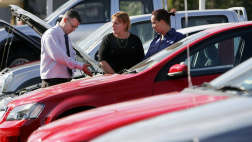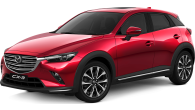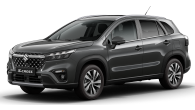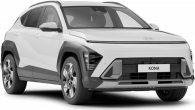Think safe, sensible and Swedish and you automatically think Volvo.
But until recently, handling and dynamics were two words you perhaps would not expect in the modern Volvo vocabulary.
The Gothenburg-based carmaker hopes the arrival of the XC60 all-wheel-drive wagon will change that.
Impeccable safety standards were a given. Volvo says the XC60 is its safest vehicle ever with a host of passive and active nannies, including the new city safety automatic braking system.
But the engineers want street credibility and respect, and that comes only with exacting dynamics and high levels of handling.
Volvo looked to Germany for inspiration and modelled the XC60's ride, steering and handling on the BMW X3, according to head of dynamics Stefan Svensson.
It is clear this Volvo is aiming high, but the company believes it can also tackle such key rivals as the Land Rover Freelander, Audi Q5, Mercedes-Benz GLK and eventually the BMW X1.
XC60 project director Lars Blenwall says designers concentrated on “finding exactly the right balance between sportiness and comfort, for the chassis and for the car as a whole”.
He believes the new city safety system, standard when the car arrives here in March, provides another persuasive safety argument.
“It is important for us to be leaders in safety,” he says.
This device uses a laser beam to automatically stop the car at speeds up to 30km/h if the system's laser detects a vehicle in front.
City safety is located behind the rearview mirror and scans up to 6m ahead.
If the system detects a crash risk, the brakes “pre-charge” to react faster if the driver touches the pedal. If the driver doesn't brake, collision avoidance kicks in to stop the car.
Blenwall says about 30 per cent of all accidents are rear-enders and in 50 per cent of those the driver does not brake at all.
Visually the XC60 shares some of its signature design traits with the rest of the XC range: strong shoulder line, rear light clusters, even a 230mm ground clearance to make it look low and sleek.
Head designer Steve Mattin describes it as the “boldest crossover so far” from Volvo.
“This car is charged with more emotive form and far more energy than any previous Volvo model,” he says. “The XC60 is the next step in modern Scandinavian design.”
The wagon also previews Volvo's new face with arched headlights, deep contoured V-shape bonnet and a pronounced grille with an enlarged Volvo badge.
The wagon is 200mm shorter than the XC70 but underneath it shares much with that model and the S80.
But the car is tuned specifically to handling in a sporty manner. The dampers are 70 per cent stiffer than those in the XC70, the rollbars 10 per cent stiffer and the XC60's steering system is much stiffer and stronger. Front and rear suspension bushings are also stiffer but, according to Blenwall, maintain good noise suppression.
The luggage compartment swallows 495 litres with the seatbacks up, 1455 litres with them folded. As in the V70 and XC70, the rear seat is a three-piece 40/20/40 split/fold unit.
The dynamic stability and traction control system has been upgraded to include a trailer stability assist system and the roll mitigation device first fitted to the XC90. Hill descent control and Volvo's Four-C adaptive suspension are expected to be optional.
In Australia there will be two models — the T6 with a 3.0-litre turbocharged six-cylinder and the D5, which shares its turbo-diesel five-cylinder engine with other Volvos.
The 3.0-litre T6 engine is based on the 3.2-litre version used in the S80. It develops 210kW at 5600 revs and 400Nm from 1500 to 4800 revs. This gives a top speed of 210km/h and a zero to 100km/h sprint time of 7.5 seconds.
Because of the engine's smaller bore and shorter stroke the turbo has a smaller displacement. This is compensated for by the latest twin-scroll turbocharger technology, delivering fast response low down in the rev range. Volvo claims it is on a par with twin turbocharged engines as far as power delivery goes.
The five-cylinder D5 diesel develops 136kW at 4000 revs and 400Nm between 2000 and 2750 revs.
It has a top speed of 200km/h and zero to 100km/h sprint time of 9.9 seconds.
As with all Volvos, the XC60 is sturdily built, making extensive use of high-strength steel. The ultra-rigid body helps with the chassis set-up and suspension tuning.
Weight is evenly distributed between the front and rear axles, which contributes to good balance and traction.
Both the diesel and petrol engines are transverse and mated to a fourth-generation Haldex all-wheel-drive system and six-speed Geartronic sequential automatic transmissions.
Volvo says the AWD system reacts quicker than previous systems.
The MacPherson front suspension and multi-link rear broad track also contribute to excellent directional stability.
Local pricing is yet to be confirmed but Volvo Cars Australia spokeswoman Laurissa Mirabelli hopes it will start at $60,000 or less.
The XC60, like the XC70, will be available in base and LE models.
Mirabelli says the company is looking at several “packs” such as a technology pack that will bundle satellite navigation, xenon headlights, blind-spot information system and Bluetooth; and a luxury pack that will include a panoramic sunroof.
A normally aspirated 2.4-litre petrol engine and lower-capacity 120kW/340Nm turbodiesel model are available in Europe but these are unlikely for Australia, Mirrabelli says.
The XC60 will also be available in front-wheel drive only in Europe but this is not expected to be part of the local line-up.
Mirabelli says the core value of the XC range includes AWD and it is something Volvo Cars Australia is likely to maintain.
However, she is quick to utter “never say never” when it comes to future models.
“All things are under evaluation,” she says.
DRIVING
The XC60 is perhaps the first Volvo all-wheel-drive in recent memory that you could seriously call sporty.
For a large, heavy wagon, that is saying something. Volvo has learned valuable lessons from BMW and managed to give the XC60 a distinctly sporty on-road personality.
Everything from the dampers and anti-roll bars to the suspension bushes and geometry are tuned for a more involving feel.
Despite using the same underpinnings as the S80 and V70 and Ford's Mondeo, the XC60 benefits from further finessing that results in a well-sorted chassis.
The ride on super-smooth European roads is good. Handling is neutral and predictable and there's a sense of spriteliness in T6 guise that belies the wagon's weight.
But all those safety systems and high-strength steel come at a price — paid in weight. The D5 auto tips the scales at 1842kg, making it 32kg heavier than the XC70 D5 but 187kg lighter than the XC90 D5. The petrol T6 is 1901kg.
Hardly surprising then that the gruff five-cylinder diesel is a slow starter off the line, though performance feels more urgent once the diesel is rolling.
The 3.0-litre six is our pick. It is smooth, quiet and accelerates rapidly to freeway speed. Throw a few twisty mountain corners at the XC60 and you'll be pleasantly surprised. There's no hint of the wallowing or steering vagueness that's felt in the XC90 or XC70.
The overall driving experience is something we've not seen in a recent Volvo off-roader. It will challenge the perception that the Swedes build safe but dynamically dull cars, and we suspect quite a few XC70 buyers — and even some XC90 buyers — will prefer the XC60 purely for its dynamics.
At any speed it is extremely refined, with superb seats and a quiet cabin, apart from some wind noise around the wing mirrors.
Visibility is also good despite the shallow glasshouse. Volvo has managed to give the XC60 strength without resorting to thick pillars that obscure vision.
Like all Volvo wagons, it has a practical boot and the 40/20/40 split seatbacks add to the car's versatility.
The XC60 also ticks all the right boxes when it comes to looks.
INSIDE VIEW
VOLVO XC60
PRICE From $60,000
ENGINES 2.4-litre five-cylinder turbodiesel (D5); 3.0-litre in-line six-cylinder (T6)
POWER 136kW at 4000 revs (D5); 210kW at 5600 revs (T6)
TORQUE 400Nm from 2000-2750 revs (D5); 400Nm from 1500-4800 revs (T6)
TRANSMISSION Six-speed sequential automatic
ECONOMY 8.3 litres/100km (D5); 11.9 litres/100km (T6)
EMISSIONS 219g/km CO2 (D6), 294g/km (T6)
Volvo XC60 2009: D5 2.4
| Engine Type | Diesel Turbo 5, 2.4L |
|---|---|
| Fuel Type | Diesel |
| Fuel Efficiency | 8.5L/100km (combined) |
| Seating | 5 |
| Price From | $6,930 - $9,790 |
| Safety Rating |
|















.jpg)
.jpg)







.png)











